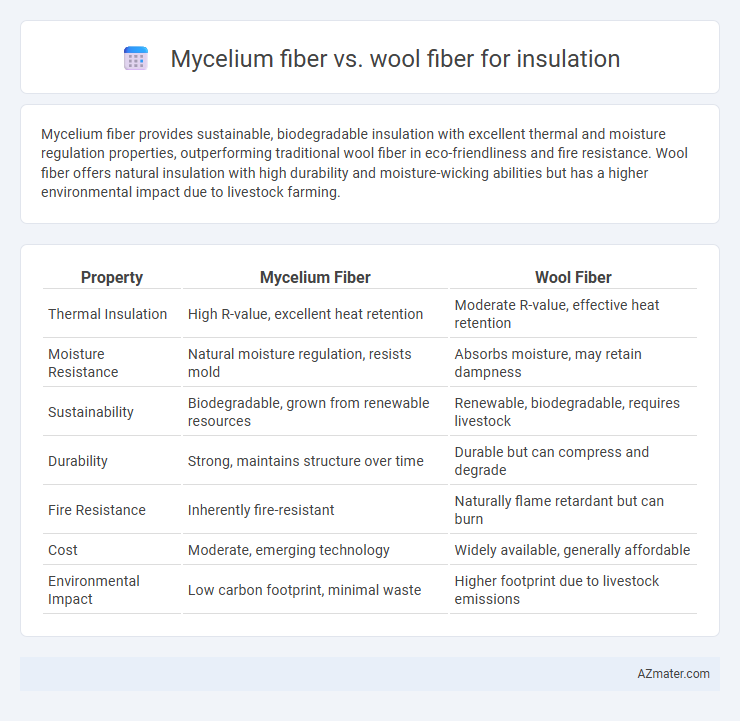Mycelium fiber provides sustainable, biodegradable insulation with excellent thermal and moisture regulation properties, outperforming traditional wool fiber in eco-friendliness and fire resistance. Wool fiber offers natural insulation with high durability and moisture-wicking abilities but has a higher environmental impact due to livestock farming.
Table of Comparison
| Property | Mycelium Fiber | Wool Fiber |
|---|---|---|
| Thermal Insulation | High R-value, excellent heat retention | Moderate R-value, effective heat retention |
| Moisture Resistance | Natural moisture regulation, resists mold | Absorbs moisture, may retain dampness |
| Sustainability | Biodegradable, grown from renewable resources | Renewable, biodegradable, requires livestock |
| Durability | Strong, maintains structure over time | Durable but can compress and degrade |
| Fire Resistance | Inherently fire-resistant | Naturally flame retardant but can burn |
| Cost | Moderate, emerging technology | Widely available, generally affordable |
| Environmental Impact | Low carbon footprint, minimal waste | Higher footprint due to livestock emissions |
Introduction: Mycelium Fiber vs Wool Fiber in Insulation
Mycelium fiber and wool fiber are innovative materials gaining attention in sustainable insulation due to their natural origin and thermal properties. Mycelium fibers offer excellent biodegradability, mold resistance, and moisture regulation, making them a promising eco-friendly alternative to traditional fibers. Wool fibers provide superior thermal insulation, natural fire resistance, and durability, with the added benefit of moisture-wicking and odor control for comfortable indoor environments.
Material Origins and Sustainability
Mycelium fiber is derived from the root structure of mushrooms, utilizing agricultural waste as its primary growth medium, making it a highly renewable and biodegradable insulation material. Wool fiber comes from sheep fleece, a natural and renewable resource but with a higher environmental impact due to methane emissions and land use associated with livestock farming. Mycelium offers superior sustainability by reducing waste and carbon footprint, whereas wool provides excellent thermal regulation but depends on extensive animal agriculture.
Fiber Structure and Physical Properties
Mycelium fiber features a natural, interconnected hyphal network that provides a lightweight, porous structure with excellent thermal insulation and moisture regulation properties, while wool fiber consists of crimped, scaly keratin strands offering high elasticity and sound absorption alongside effective heat retention. The cellular arrangement of mycelium fibers enables superior breathability and resistance to mold compared to wool, which is naturally water-repellent yet prone to compression under prolonged pressure. Both fibers exhibit biodegradability and fire resistance, but mycelium's rigid, foam-like matrix often results in enhanced structural stability for insulation applications relative to the more flexible and hygroscopic wool fibers.
Thermal Insulation Performance
Mycelium fiber exhibits excellent thermal insulation properties due to its low thermal conductivity, providing effective heat resistance comparable to traditional wool fiber. Wool fiber benefits from natural crimp and moisture-regulating abilities, enhancing its insulating performance especially in varying humidity conditions. Mycelium fiber's biodegradability and resistance to mold make it a sustainable and efficient alternative for thermal insulation applications.
Moisture Resistance and Breathability
Mycelium fiber offers superior moisture resistance compared to wool fiber, effectively repelling water while maintaining structural integrity in damp conditions. Wool fiber excels in breathability, allowing efficient moisture vapor transmission that prevents condensation and mold growth inside insulation layers. Combining mycelium's moisture-blocking properties with wool's breathable nature optimizes insulation performance in varying humidity environments.
Durability and Lifespan Comparison
Mycelium fiber offers superior resistance to moisture and mold compared to wool fiber, enhancing its durability in insulation applications. Wool fiber excels in natural resilience and self-healing properties but is more susceptible to pest damage and degradation over time. The lifespan of mycelium insulation typically exceeds wool, lasting up to 30 years under optimal conditions, while wool insulation generally endures around 15-20 years with proper maintenance.
Fire Resistance and Safety Ratings
Mycelium fiber offers superior fire resistance compared to traditional wool fiber, as it naturally chars without emitting toxic fumes, enhancing safety in insulation applications. Wool fiber, while flame retardant to a degree due to its high nitrogen and water content, tends to smolder and release smoke, posing potential hazards in fires. Fire safety ratings for mycelium insulation often surpass those of wool, making mycelium a more effective and eco-friendly choice for fire-resistant building materials.
Environmental Impact and Compostability
Mycelium fiber offers a significantly lower environmental impact compared to wool fiber, as it is cultivated from fungi with minimal resource use, reducing greenhouse gas emissions and land degradation. Unlike wool, which involves animal farming and associated methane emissions, mycelium fiber is entirely plant-based and accelerates soil regeneration when composted. Both materials are compostable, but mycelium decomposes faster, returning nutrients to the soil within weeks, whereas wool takes several months due to its keratin protein structure.
Cost and Accessibility Factors
Mycelium fiber insulation offers a cost-effective alternative to traditional wool fiber, benefiting from rapid cultivation and low material processing expenses. Wool fiber, while naturally insulating and fire-resistant, generally incurs higher costs due to animal husbandry and harvesting complexities. Accessibility for mycelium fiber is increasing with expanding biotechnological advancements, whereas wool remains regionally dependent on sheep farming industries.
Applications and Future Prospects
Mycelium fiber offers sustainable insulation with excellent thermal and acoustic properties, ideal for eco-friendly construction and packaging industries, while wool fiber excels in moisture regulation and fire resistance, making it suitable for both residential and commercial insulation. Innovations in mycelium cultivation and processing promise scalable, biodegradable insulation solutions with lower environmental impact compared to traditional materials. The future of insulation leverages mycelium's rapid growth and biodegradability alongside wool's natural resilience, fostering hybrid materials that enhance performance and sustainability in building applications.

Infographic: Mycelium fiber vs Wool fiber for Insulation
 azmater.com
azmater.com